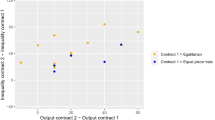Abstract
Even if the managers are well aware of the abilities of their subordinates, they often have to use uniform systems of labor remuneration, that is, to fix the payments to the employees so that they are defined uniformly exceptionally by the results of their work, rather than directly by their abilities. The present work studied the properties of uniform systems of labor remuneration in the active systems consisting of a principal and several subordinated agents. Realization of identical actions by various agents was considered in detail. Relationship between the stimulation function and the function of action, which is understood as the dependence of the vector of actions chosen by the agent on its abilities, was studied.
Similar content being viewed by others
REFERENCES
Kamien, M.I. and Schwartz, N.L., Dynamic Optimization: The Calculus of Variations and Optimal Control in Economics and Management, New York: Elsevier, 1991.
Burkov, V.N. and Kondrat'ev, V.V., Mekhanizmy funktsionirovaniya organizatsionnykh sistem (Mechanisms of Organizational Systems), Moscow: Nauka, 1981.
Burkov, V.N., Gureev, A.B., Novikov, D.A. et al., Efficiency of the Rank Stimulation Systems, Avtom. Telemekh., 2000, no. 8, pp. 115-125.
Novikov, D.A. and Petrakov, S.N., Kurs teorii aktivnykh sistem (A Course in the Theory of Active Systems), Moscow: SINTEG, 1999.
Korgin, N.A., Incentive Problems and Exchange Schemes, Avtom. Telemekh., 2001, no. 10, pp. 147-153.
Salanie, B., The Economics of Contracts: A Primer, Cambridge: MIT Press, 2000.
Hart, O. and Holmstrom, B., The Theory of Contracts, in “Advances in Economic Theory", Bewley, T., Ed., Cambridge: Cambridge Univ. Press, 1987, pp. 57-121.
Mas-Colell, A., Whinston, M., and Green, J.R., Microeconomic Theory, New York: Oxford Univ. Press, 1995.
Novikov, D.A. and Tsvetkov, A.N., Mekhanizmy stimulirovaniya v mnogoelementnykh sistemakh (Stimulation Mechanisms in Multiagent Systems), Moscow: Apostrof, 2000.
Barkalov, S.A., Novikov, D.A., and Popov, S.S., Individual'nye strategii predlozheniya truda: teoriya i praktika (Individual Strategies of Offer of Labor: Theory and Practice), Moscow: Inst. Probl. Upravlen., 2002.
Author information
Authors and Affiliations
Rights and permissions
About this article
Cite this article
Karavaev, A.P. Uniform Stimulation Systems. Automation and Remote Control 64, 104–137 (2003). https://doi.org/10.1023/A:1021880526462
Issue Date:
DOI: https://doi.org/10.1023/A:1021880526462




